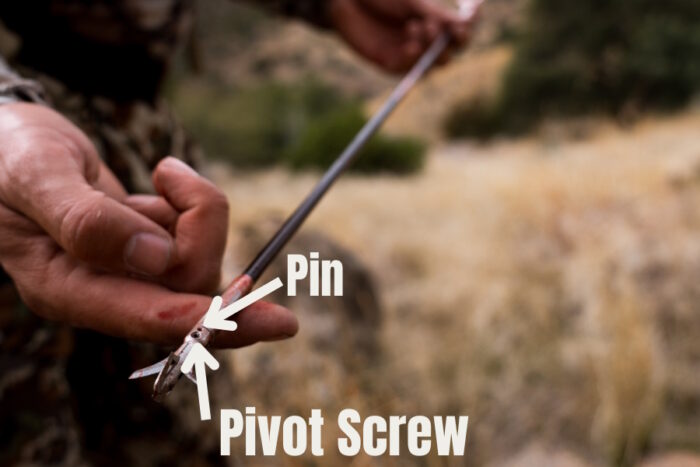The age-old question of fixed-blade versus mechanical broadhead is one that may never stop being asked. The answer for me was simple. All it took was for someone to ask me, “Why not both?” Since then, I’ve been a fan of hybrid broadheads.
Not all hybrid broadheads are created equal, though. The Hyde from Evolution Outdoors has become my new best friend in that category, for a number of reasons.
In short: From exceptional flight to devastation upon impact, the Hyde from Evolution Outdoors is a winner of a broadhead through and through.
Pros
- Exceptional flight
- Hybrid head gives best of both worlds (fixed and mechanical)
- Big wound channel
Cons
- Getting marred pin out to replace can be tricky
Evolution Outdoors Hyde Broadhead Review
Overview
Evolution Outdoors was started by Dale Perry in Phoenix. It’s a company that prides itself on providing hunters with products that deliver results, not gimmicks. And the Hyde broadhead is no exception to that. This is a low-profile, hybrid, cut-on-contact broadhead.
The sizes offered include 100 gr (7075 aircraft aluminum), 125 gr (416 hardened stainless steel), and 150 gr (416 hardened stainless steel). They even offer a 100 gr crossbow version (7075 aircraft aluminum). Evolution offers these in three-, four-, five, and six-pack options.
The front of the Hyde is equipped with a 3/4-inch blade that is backed up with a 2-inch cutting diameter mechanical blade. A devastating combo, to say the least. Those blades are held in place by the Evolution patented blade locking technology. All broadheads are machined and assembled in the U.S.
Features
Multifunctional Ferrule
A true gem of the Hyde broadhead is its versatility. I’m not just referring to the fact that it’s a hybrid broadhead, either. I’m referring to the ferrule. These ferrules are multifunctional, giving you the option to turn a Hyde into the Evolution Jekyll (fixed), Turkey Wrecker, or Whitetail Fury.
By simply unscrewing the mechanical blades, you can install any of the other appropriate blades that Evolution Outdoors offers. It’s one ferrule to rule them all.
Blade Locking System and Deployment

Another unique feature of the Hyde broadhead is the blade locking system and deployment. The blades pivot on a pivot screw, which comes preset in terms of tightness for hunting. A locking screw holds a small pin in place just below that. This pin helps hold the blades in place.

Every time the blades open, this pin is marred a bit, which makes the blades easier to open time after time. It is recommended to replace this pin after each opening in order to have those blades held securely at all times. Even with the pin marred, these blades are still not going to open in flight. Evolution includes replacement pins with your purchase.
For practice, I’d recommend one of two things. The best option is to just use the Evolution practice head and not mar your pins on a target. I either do this or simply shoot the Jekyll for practice because they both fly the same.
Exceptional Flight

Last but certainly not least, I need to mention the exceptional flight that this broadhead provides. Dale Perry is really big on accuracy, and he 100% took that into consideration with the design of his broadheads.
The Hyde and all of the Evolution Outdoors broadheads are low profile and very aerodynamic. It all started with a wind tunnel test that Dale did, which was an influential piece in the design of this head. These will fly with your field points through a tuned bow. And they’ll do it consistently. There are no “fliers” here.
My Experience

I have extensive experience with Dale’s broadheads, and it didn’t start with Evolution Outdoors. Dale is the original inventor of the Gravedigger broadhead, another hybrid head. For years, this was “the broadhead” in my home state of Arizona. So, when Dale came out with the next evolution of his broadheads, I was all ears with no hesitation.
Before using the Hyde broadhead, I actually used the Jekyll and had success with it. So, when I switched over to the Hyde, I had no doubt it would perform, and it didn’t disappoint. Just like I thought, and a lateral move from the Jekyll, the Hyde flew right with my field tips out to 80+ yards. A perfect range of confidence for the coues deer hunt I had planned.

On the fifth day of hunting, I was able to bend the limbs back on a coues buck. The buck went 20 yards, but more impressively, the broadhead went through and through bone and didn’t break.
I’m not saying that I could use the head again, and I honestly am not a guy who does that sort of thing. With that said, it was nice to see, and it instilled even more confidence in me for the broadhead. Nonetheless, I’m a fan.
What’s Wrong
There is one thing about the Hyde broadhead that some might find an issue with. It’s the process of replacing that pin. It can be tricky getting the marred pin out. Putting the new one in is a breeze. Once you get the hang of it, it’s no big deal, and I think Evolution Outdoors recently made an improvement to the design to make it even easier.
Final Thoughts

Gaining trust in a broadhead is not something that happens overnight, and it never will be. It takes a lot of arrows downrange to trust the influence a broadhead has on arrow flight. And the amount of opportunities to get those broadheads to touch critters are few and far between. From what I have seen and experienced, along with those close in my circle, the Hyde is no joke. Elk, deer, black bear, it doesn’t matter. The Hyde will do it in flying colors, mostly red.









